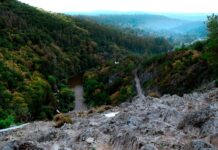Though the cold weather and dark days of winter may discourage time outdoors, hiking during these months can be a fantastic and memorable experience. Crowds disappear, silence reigns, and landscapes take on a glittery and frost-covered splendor. Here are a few practical tips to help ensure a positive hiking experience for you and your loved ones.
-Winter hiking takes longer than summer hiking – you tend to move slower and encounter more obstacles. Plan accordingly.
-Plan ahead to ensure a safe and enjoyable time. Check the weather forecast, call the park for trail conditions, and understand the physical limitations of everyone in your group.
Technological devices tend to malfunction in cold temperatures, so be prepared by bringing extra batteries/battery packs and try to keep your devices warm. Don’t rely on your phone.
-Tell others your plan. Leave your expected itinerary and estimated time of return with a loved one.
-Snowpack can hide the trail and trail markers making it easier to get lost. Pay attention and know how to use a map.
-Dress in lots of layers and pack a waterproof shell. Choose materials that dry quickly (not cotton) and be sure to shed layers to prevent yourself from getting too warm. When you take a break, your body will chill quickly (especially if your clothes get damp), so layer back up to maintain your temperature.
-Exercising in winter burns more calories, so you need to stay nourished. This will help keep you warm, too.
-Dehydration expedites the onset of hypothermia, so stay hydrated. If you feel thirsty, you’re already dehydrated.
-Remember to eat and drink: When it’s cold outside, you might be less inclined to stop for food and water. Make it simple by keeping snacks and water within reach so you can eat and sip regularly throughout the day.
-Keep food from freezing: Nobody enjoys chomping on a rock-hard energy bar. Foods like candy bars, chocolate, nuts and cheese tend to stay softer than some other items in cold weather. You may have to experiment to figure out the foods you enjoy that will stay edible in cold weather. Whatever you choose to bring, stowing food close to your body will help keep it thawed.
-Use water bottles: In very cold temperatures, you may need to give up the hydration reservoir and use water bottles because the chance of your drink tube freezing is too high. But, bottles can freeze, too, and it usually happens from the top down, which means the bottle tops are prone to getting stuck shut. Flipping your bottles upside down will solve that problem (just be sure your bottles don’t leak and that the tops are screwed shut securely). Putting the bottles in your pack rather than in exterior pockets will help insulate them from the cold.
-Pack warm drinks: Fill up a vacuum-insulated bottle with hot tea or hot chocolate to sip on when you take a break. The warmth goes a long way toward keeping you comfortable.
-Preventing Frostbite and Hypothermia- It’s so much easier to stay warm than to get warm. By dressing appropriately, you can maintain a comfortable temperature, which is much simpler than trying to warm up after getting too cold. If you feel your fingers or toes getting cold, stop and take the time to check on them and warm them up. Placing cold fingers in your armpits or cold toes on a partner’s warm belly are good ways to warm up. Using hand warmer and toe warmer packets is also effective. A good hiking partner keeps an eye on their buddies. Regularly ask your friends how they’re doing and if you see pale spots on your friend’s face or they’re starting to get clumsy on the trail, make them stop and cover up exposed skin or add a warm insulating layer.
Views: 77






